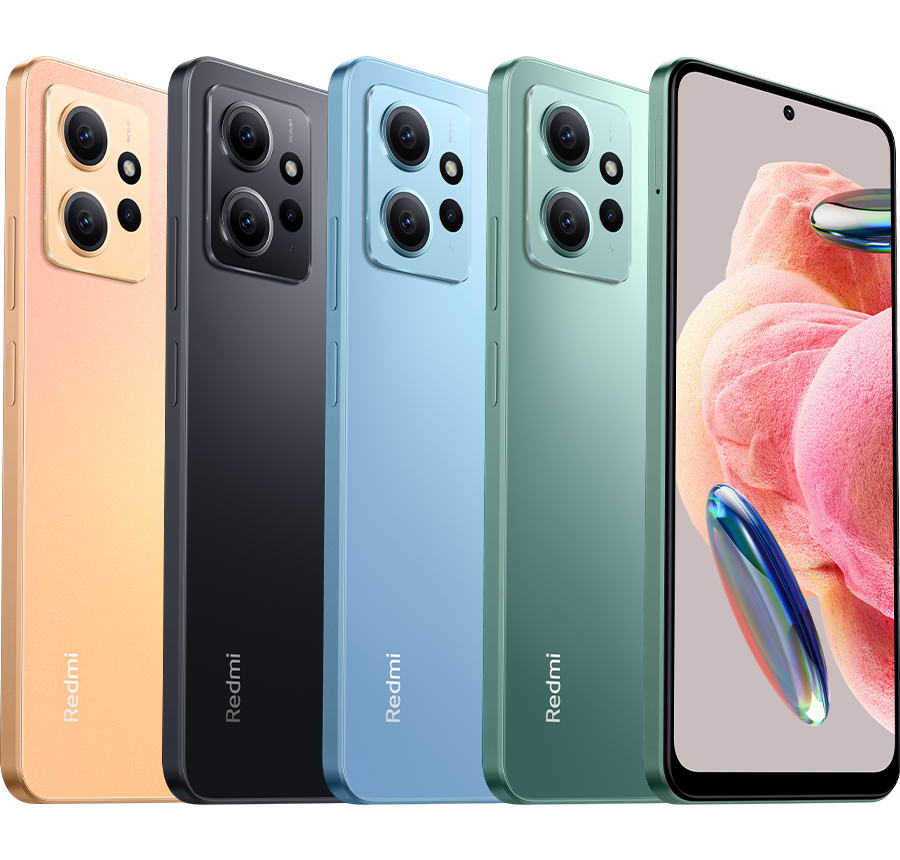Are you considering purchasing a new smartphone for less than €200? We have selected the Samsung Galaxy A14 5G, Xiaomi Redmi Note 13, and Xiaomi Redmi Note 12 models for you. But among these, which one is really made for you? We have compared their characteristics so that you can see more clearly and select yours.
Toc
Overview of Xiaomi Redmi Note 12

In terms of design, each model has unique characteristics that could influence your choice. The Samsung Galaxy A14 5G sports a minimalist design with photo sensors seemingly placed on the rear shell, offering a clean look. It is available in black, lime, silver, and lavender, with a glossy finish and light texture on the back. The Xiaomi Redmi Note 13 and Redmi Note 12, for their part, display their sensors on a slightly protruding plate that blends into the color of the phone, available in black, blue and green. The profiles of all three models are relatively flat with a slight curvature at the edges for better grip.
Dimensions vary slightly between models: the Samsung Galaxy A14 5G is the largest (167.7x78x9.1 mm and 205 grams), while the Xiaomi Redmi Note 13 is the thinnest (162.24×75.55×7.97 mm and 188.5 grams), offering a more compact and lightweight alternative. The Redmi Note 12 has a thickness comparable to that of the Redmi Note 13 but is slightly heavier since it weighs 183 grams. These differences, although small, can be decisive depending on your size and weight preferences for daily use.
All models are equipped with a 5000 mAh battery, promising good autonomy in use. However, the Xiaomi Redmi Note 13 and 12 models stand out for their supported charging power of 33 watts, compared to only 15 watts for the Samsung Galaxy A14 5G, offering a significant advantage in terms of charging speed. None of the models offer wireless charging.
Which is the most powerful and which is the best screen?
The Samsung Galaxy A14 5G is equipped with a MediaTek Dimensity 700 processor, with 4 GB of RAM, providing adequate performance for daily tasks. In terms of storage, it offers 64 GB or 128 GB options, expandable via micro SD. The Xiaomi Redmi Note 13 and Redmi Note 12 are equipped with the Qualcomm Snapdragon 685. The Redmi Note 13 offers 6 GB or 8 GB of RAM and storage capacities of 128 GB or 256 GB. The Redmi Note 12 is available with 4 GB of RAM and up to 128 GB of storage. Both Xiaomi models also support memory expansion via micro SD. Ranking these smartphones from most to least powerful, the Redmi Note 13 and 12 slightly outperform the Galaxy A14 5G thanks to their newer processor and higher RAM options.
In terms of screens, the Samsung Galaxy A14 5G offers a 6.6-inch LCD panel with a refresh rate of 90 Hz. The Xiaomi Redmi Note 13 and 12, on the other hand, offer 6.67-inch AMOLED screens with a refresh rate of 90 Hz. 120Hz refresh rate, promising not only better display quality but also a smoother visual experience. The Redmi Note 13 particularly shines with an impressive peak brightness of 1800 cd/m², while the Redmi Note 12 also offers excellent brightness at 1200 cd/m². Considering the display quality, the Redmi Note 13 stands out as the most attractive, closely followed by the Redmi Note 12, leaving the Samsung Galaxy A14 5G in third place.
What configurations for photos and what connectivity?
Regarding the camera configurations, the Xiaomi Redmi Note 13 is equipped with a 108-megapixel primary sensor, followed by an 8-megapixel ultra-wide-angle and a 2-megapixel macro. The selfie sensor is 16 megapixels. The Redmi Note 12 shares a similar secondary camera setup but opts for a 50-megapixel primary sensor and a 13-megapixel selfie camera. The Samsung Galaxy A14 5G has a 50-megapixel main sensor, complemented by two 2-megapixel sensors for portraits and macros, with a 13-megapixel selfie sensor. In terms of photographic capability, the Redmi Note 13 takes the lead thanks to its more capable main sensor, offering better image quality, followed by the Redmi Note 12 and the Galaxy A14 5G.
For connectivity, all models support Wi-Fi 5 and Bluetooth, with a jack retained for plugging in headphones. The Redmi Note 13 and 12 add an infrared emitter and IP54 waterproof certification, giving them an extra edge in practical features. The Redmi Note 13’s fingerprint reader is integrated under the screen, offering a cleaner aesthetic and increased accessibility, while the one on the Redmi Note 12 and Samsung Galaxy A14 5G is located on the profile, which can be less practical for some users.
Additional Features to Consider in a Smartphone

Besides the characteristics compared between these three models, there are other features to consider when selecting a smartphone. These include:
Operating System
The Xiaomi Redmi Note 13 and Redmi Note 12 run on Android 11 with MIUI 12, while the Samsung Galaxy A14 5G runs on Android 10 with One UI 2.5. Depending on your preferences, you may prefer one operating system over the other.
Security Features
While all three models offer fingerprint readers, the Redmi Note 13 stands out with its under-screen fingerprint sensor for added security and convenience. The Samsung Galaxy A14 5G also offers facial recognition as an additional biometric security feature.
Customization Options
The MIUI 12 interface on the Xiaomi models allows for a high level of customization and personalization, while the One UI interface on the Samsung model is known for its user-friendly design and features.
Software Updates
Xiaomi and Samsung both regularly release software updates for their devices, but Xiaomi may be slightly faster in delivering the latest Android updates compared to Samsung.
Price
Of course, price is an important factor to consider when choosing a smartphone. The Samsung Galaxy A14 5G is generally the most affordable option among these three models, while the Redmi Note 13 and 12 offer more advanced features at a higher price point. Ultimately, it’s important to consider your budget and prioritize which features are most important to you when making a decision.
Final Verdict
In conclusion, if you are looking for a powerful and visually impressive smartphone with good camera capabilities, the Xiaomi Redmi Note 13 would be the ideal choice. The Redmi Note 12 offers similar features but at a slightly lower price point, making it an attractive option for budget-conscious consumers. However, if you prioritize battery life and charging speed over other features, the Samsung Galaxy A14 5G may be the better option for you. Ultimately, your personal preferences and usage habits will determine which one of these models is truly made for you. So take some time to consider each aspect and choose the model that best fits your needs and preferences. Happy phone shopping!










